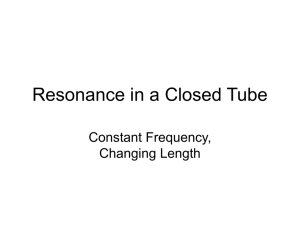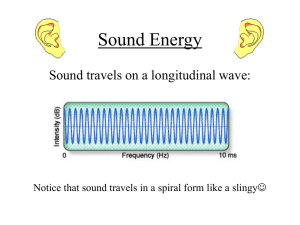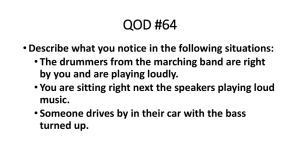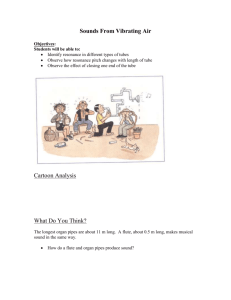Physics Chapter 5, Section 4
advertisement
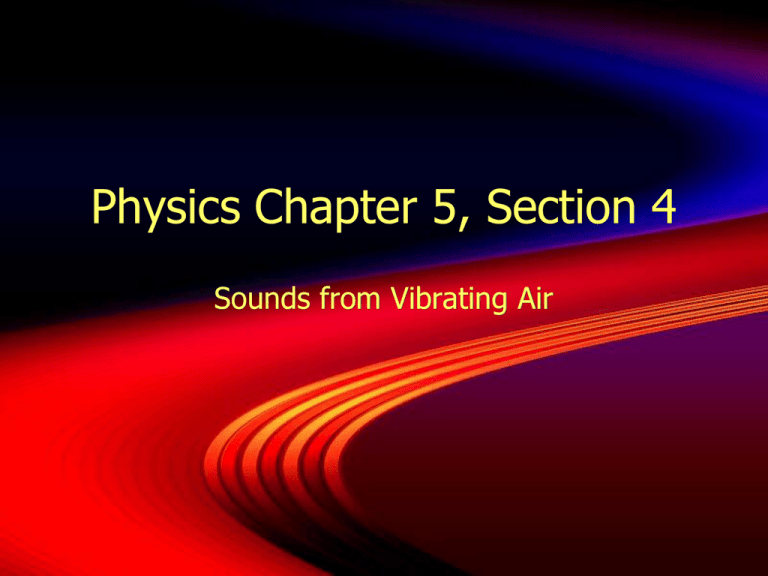
Physics Chapter 5, Section 4 Sounds from Vibrating Air HW: p 526 #1, 4-6 Learning Objective Explain how sound is produced by longitudinal compression waves Write a conclusion that includes IV, DV, evidence, and the big idea Success Criteria Identify standing waves in different kinds of air-filled tubes Observe how pitch changes with the length of the tube Observe the effect of closing one end of the tube on the pitch of the sound Observe sound bending around corners and spreading Relate observations of pitch to drawings of standing waves Organize observations to find a pattern Do Now Write LO and SC on new left page p 518 WDYS/WDYT Agenda Do Now Investigation 5.4 Summary Investigation 5.4 Part A (groups) 1-3 - with straws 4, 5 with test tubes Part B 1 - Class demo 2 - with group Part C In groups HW: p 526 #1, 4-6 Learning Objective Explain how sound is produced by longitudinal compression waves Write a conclusion that includes IV, DV, evidence, and the big idea Success Criteria Identify standing waves in different kinds of air-filled tubes Observe how pitch changes with the length of the tube Observe the effect of closing one end of the tube on the pitch of the sound Observe sound bending around corners and spreading Relate observations of pitch to drawings of standing waves Organize observations to find a pattern Do Now How did closing the end of the tube change the sound? Agenda Do Now Investigation 5.4 Summary Physics Talk 5.4 What kind of waves does sound make? Compressional (longitudinal) waves How does this relate to springs? QuickTime™ and a decompressor are needed to see this picture. Physics Talk 5.4 What was the medium the sound traveled through? The air in the straw or tube Physics Talk 5.4 How do these related to the standing waves created by the stringed instrument? Air molecules cannot vibrate at the bottom of the test tube, so this is a node of the wave The open end of the test tube provides the wave’s amplitude The vibration of the air at this end, is the sound you hear This is the antinode of the wave Physics Talk 5.4 What is diffraction? The ability of sound waves to spread out or change direction as the emerge from an opening This is why you can hear someone talking around a corner Physics Talk 5.4 The top show a large amount of diffraction, when the opening is smaller The bottom shows a small amount of diffraction, since the opening is larger Physics Talk 5.4 How do megaphones work? A megaphone increases the diffraction of sound, due to the small opening you tell into The best opening size depends on the sound being produced Vibrating Columns of Air QuickTime™ and a decompressor are needed to see this picture. Physics Talk How does changing wavelength effect frequency? When keeping a constant wave speed, increasing the wavelength will decrease the frequency - causing a lower pitch Physics Talk 5.4 Open tube wavelength Closed tube wavelength Half of the wavelength will fit The wavelength is 2x the length of the tube One quarter of the wavelength will fit The wavelength is 4x the length of the tube Physics Talk 5.4 Why does the closed straw have a lower pitch? Why does the open straw have a higher pitch? The wavelength is longer (4x), meaning the frequency is lower The wavelength is shorter (2x), meaning the frequency is higher What do you think now? How do flutes and organ pipes produce sound? USE PHYSICS!


